Accounting & Decision Making: Financial Analysis of Crystal Hotel
VerifiedAdded on 2023/06/08
|9
|1625
|363
Report
AI Summary
This report provides a comprehensive financial analysis of Crystal Hotel Private Limited, utilizing accounting and decision-making principles. It begins with an income statement comparative analysis, benchmarking Crystal Hotel's performance against industry standards, focusing on revenue streams and cost management. Ratio analysis is then employed to assess the hotel's profitability, solvency, liquidity, and efficiency. The report highlights areas where Crystal Hotel excels, such as room revenue, and identifies areas for improvement, including cost of sales and net profit levels. Furthermore, the report compares the hotel's performance against industry-specific benchmarks, evaluating employee turnover, room pricing strategies, and credit policies. The conclusion emphasizes the need for Crystal Hotel to improve its net profit, reduce expenses, and optimize cash flows to enhance overall financial performance. This analysis aims to provide actionable insights for the hotel's management to make informed strategic decisions.
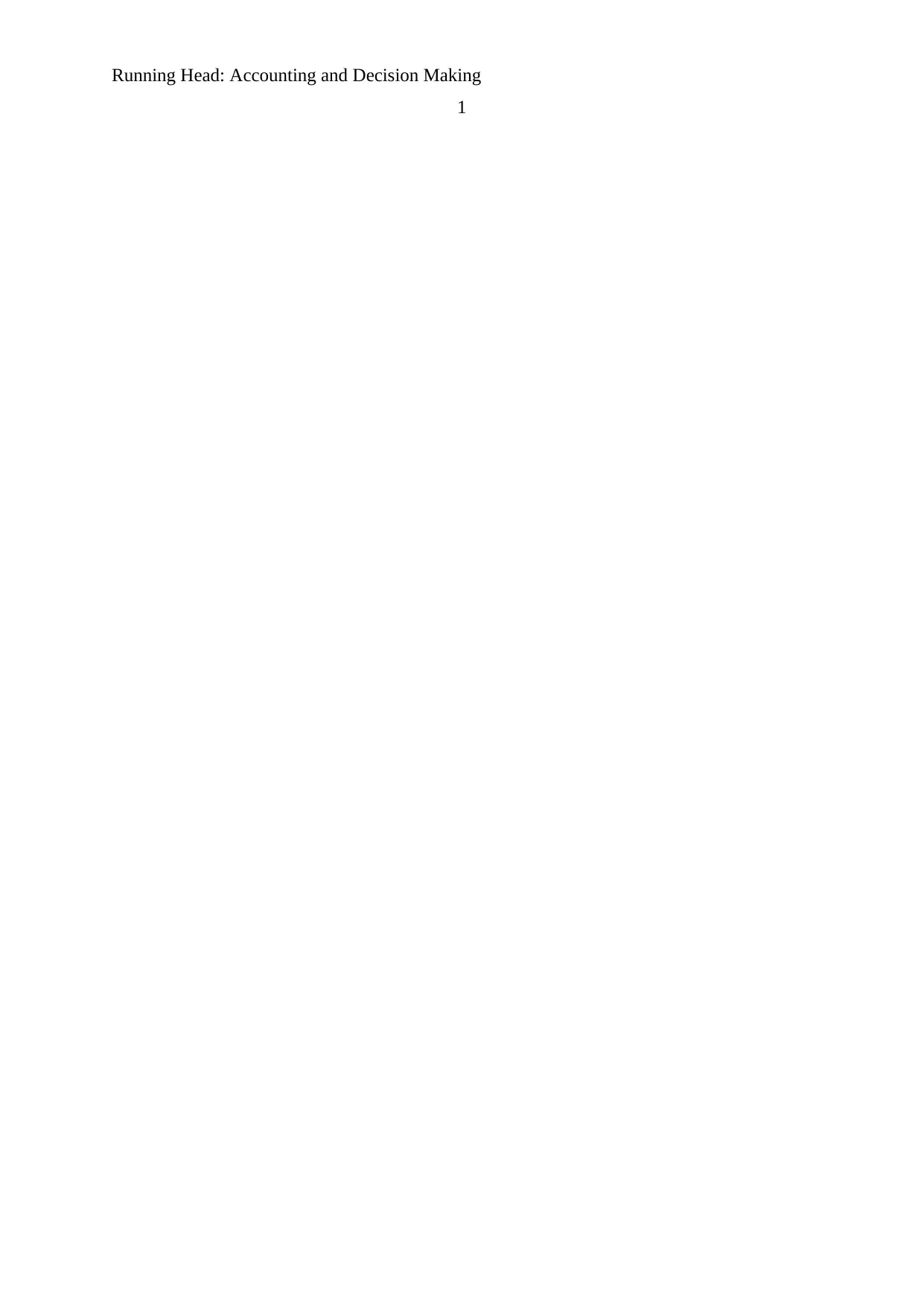
Running Head: Accounting and Decision Making
1
1
Paraphrase This Document
Need a fresh take? Get an instant paraphrase of this document with our AI Paraphraser
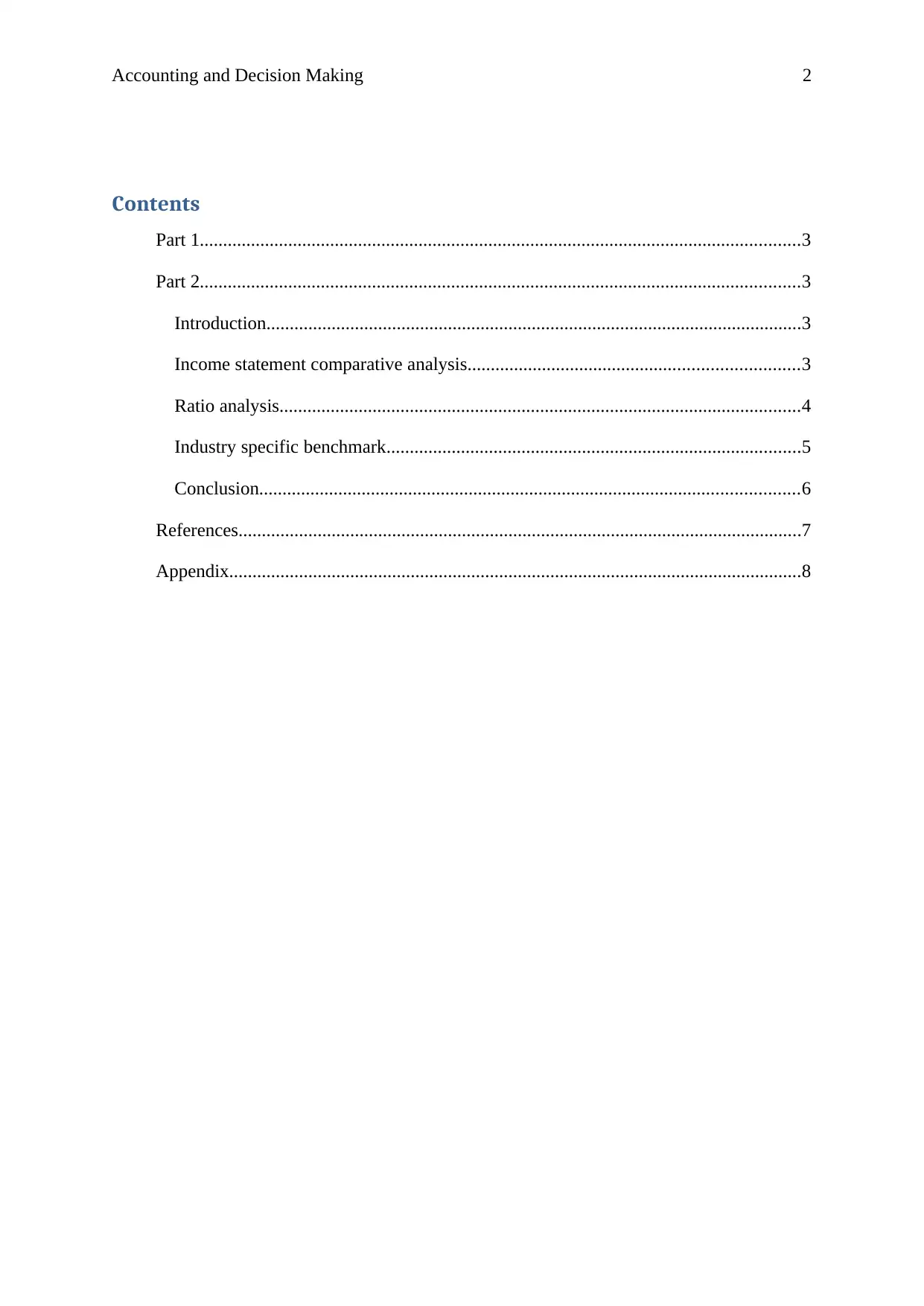
Accounting and Decision Making 2
Contents
Part 1.................................................................................................................................3
Part 2.................................................................................................................................3
Introduction...................................................................................................................3
Income statement comparative analysis.......................................................................3
Ratio analysis................................................................................................................4
Industry specific benchmark.........................................................................................5
Conclusion....................................................................................................................6
References.........................................................................................................................7
Appendix...........................................................................................................................8
Contents
Part 1.................................................................................................................................3
Part 2.................................................................................................................................3
Introduction...................................................................................................................3
Income statement comparative analysis.......................................................................3
Ratio analysis................................................................................................................4
Industry specific benchmark.........................................................................................5
Conclusion....................................................................................................................6
References.........................................................................................................................7
Appendix...........................................................................................................................8
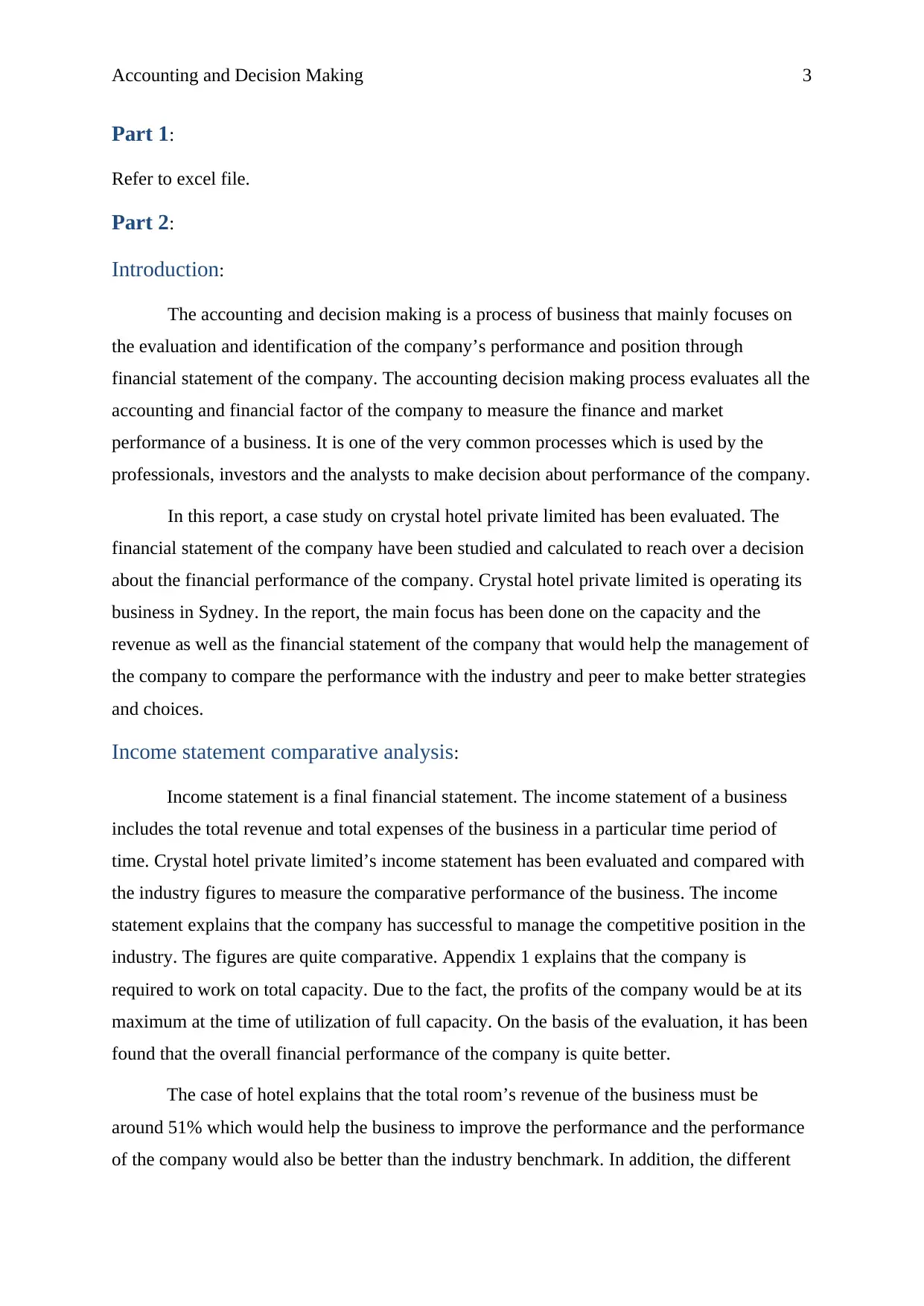
Accounting and Decision Making 3
Part 1:
Refer to excel file.
Part 2:
Introduction:
The accounting and decision making is a process of business that mainly focuses on
the evaluation and identification of the company’s performance and position through
financial statement of the company. The accounting decision making process evaluates all the
accounting and financial factor of the company to measure the finance and market
performance of a business. It is one of the very common processes which is used by the
professionals, investors and the analysts to make decision about performance of the company.
In this report, a case study on crystal hotel private limited has been evaluated. The
financial statement of the company have been studied and calculated to reach over a decision
about the financial performance of the company. Crystal hotel private limited is operating its
business in Sydney. In the report, the main focus has been done on the capacity and the
revenue as well as the financial statement of the company that would help the management of
the company to compare the performance with the industry and peer to make better strategies
and choices.
Income statement comparative analysis:
Income statement is a final financial statement. The income statement of a business
includes the total revenue and total expenses of the business in a particular time period of
time. Crystal hotel private limited’s income statement has been evaluated and compared with
the industry figures to measure the comparative performance of the business. The income
statement explains that the company has successful to manage the competitive position in the
industry. The figures are quite comparative. Appendix 1 explains that the company is
required to work on total capacity. Due to the fact, the profits of the company would be at its
maximum at the time of utilization of full capacity. On the basis of the evaluation, it has been
found that the overall financial performance of the company is quite better.
The case of hotel explains that the total room’s revenue of the business must be
around 51% which would help the business to improve the performance and the performance
of the company would also be better than the industry benchmark. In addition, the different
Part 1:
Refer to excel file.
Part 2:
Introduction:
The accounting and decision making is a process of business that mainly focuses on
the evaluation and identification of the company’s performance and position through
financial statement of the company. The accounting decision making process evaluates all the
accounting and financial factor of the company to measure the finance and market
performance of a business. It is one of the very common processes which is used by the
professionals, investors and the analysts to make decision about performance of the company.
In this report, a case study on crystal hotel private limited has been evaluated. The
financial statement of the company have been studied and calculated to reach over a decision
about the financial performance of the company. Crystal hotel private limited is operating its
business in Sydney. In the report, the main focus has been done on the capacity and the
revenue as well as the financial statement of the company that would help the management of
the company to compare the performance with the industry and peer to make better strategies
and choices.
Income statement comparative analysis:
Income statement is a final financial statement. The income statement of a business
includes the total revenue and total expenses of the business in a particular time period of
time. Crystal hotel private limited’s income statement has been evaluated and compared with
the industry figures to measure the comparative performance of the business. The income
statement explains that the company has successful to manage the competitive position in the
industry. The figures are quite comparative. Appendix 1 explains that the company is
required to work on total capacity. Due to the fact, the profits of the company would be at its
maximum at the time of utilization of full capacity. On the basis of the evaluation, it has been
found that the overall financial performance of the company is quite better.
The case of hotel explains that the total room’s revenue of the business must be
around 51% which would help the business to improve the performance and the performance
of the company would also be better than the industry benchmark. In addition, the different
⊘ This is a preview!⊘
Do you want full access?
Subscribe today to unlock all pages.

Trusted by 1+ million students worldwide
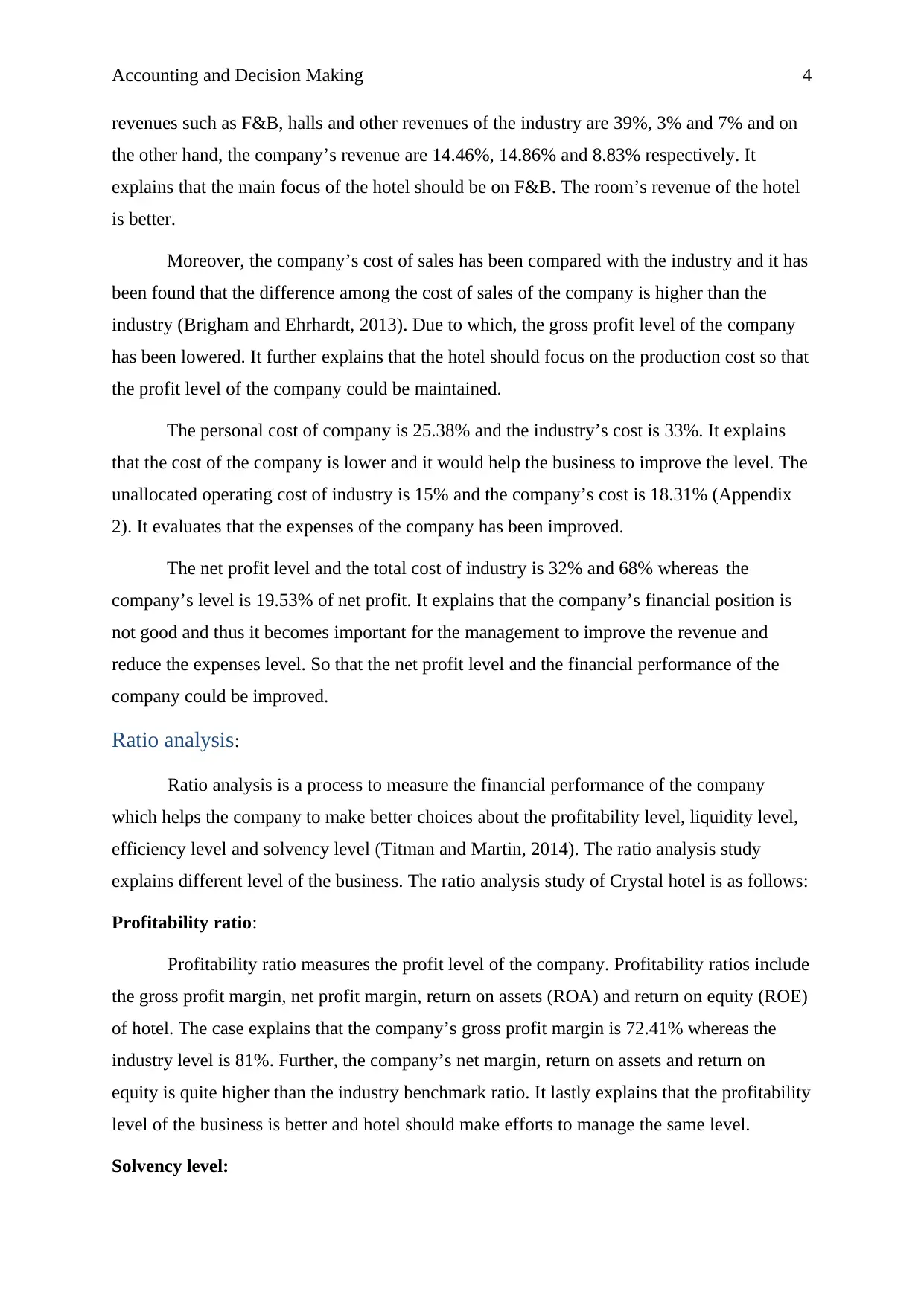
Accounting and Decision Making 4
revenues such as F&B, halls and other revenues of the industry are 39%, 3% and 7% and on
the other hand, the company’s revenue are 14.46%, 14.86% and 8.83% respectively. It
explains that the main focus of the hotel should be on F&B. The room’s revenue of the hotel
is better.
Moreover, the company’s cost of sales has been compared with the industry and it has
been found that the difference among the cost of sales of the company is higher than the
industry (Brigham and Ehrhardt, 2013). Due to which, the gross profit level of the company
has been lowered. It further explains that the hotel should focus on the production cost so that
the profit level of the company could be maintained.
The personal cost of company is 25.38% and the industry’s cost is 33%. It explains
that the cost of the company is lower and it would help the business to improve the level. The
unallocated operating cost of industry is 15% and the company’s cost is 18.31% (Appendix
2). It evaluates that the expenses of the company has been improved.
The net profit level and the total cost of industry is 32% and 68% whereas the
company’s level is 19.53% of net profit. It explains that the company’s financial position is
not good and thus it becomes important for the management to improve the revenue and
reduce the expenses level. So that the net profit level and the financial performance of the
company could be improved.
Ratio analysis:
Ratio analysis is a process to measure the financial performance of the company
which helps the company to make better choices about the profitability level, liquidity level,
efficiency level and solvency level (Titman and Martin, 2014). The ratio analysis study
explains different level of the business. The ratio analysis study of Crystal hotel is as follows:
Profitability ratio:
Profitability ratio measures the profit level of the company. Profitability ratios include
the gross profit margin, net profit margin, return on assets (ROA) and return on equity (ROE)
of hotel. The case explains that the company’s gross profit margin is 72.41% whereas the
industry level is 81%. Further, the company’s net margin, return on assets and return on
equity is quite higher than the industry benchmark ratio. It lastly explains that the profitability
level of the business is better and hotel should make efforts to manage the same level.
Solvency level:
revenues such as F&B, halls and other revenues of the industry are 39%, 3% and 7% and on
the other hand, the company’s revenue are 14.46%, 14.86% and 8.83% respectively. It
explains that the main focus of the hotel should be on F&B. The room’s revenue of the hotel
is better.
Moreover, the company’s cost of sales has been compared with the industry and it has
been found that the difference among the cost of sales of the company is higher than the
industry (Brigham and Ehrhardt, 2013). Due to which, the gross profit level of the company
has been lowered. It further explains that the hotel should focus on the production cost so that
the profit level of the company could be maintained.
The personal cost of company is 25.38% and the industry’s cost is 33%. It explains
that the cost of the company is lower and it would help the business to improve the level. The
unallocated operating cost of industry is 15% and the company’s cost is 18.31% (Appendix
2). It evaluates that the expenses of the company has been improved.
The net profit level and the total cost of industry is 32% and 68% whereas the
company’s level is 19.53% of net profit. It explains that the company’s financial position is
not good and thus it becomes important for the management to improve the revenue and
reduce the expenses level. So that the net profit level and the financial performance of the
company could be improved.
Ratio analysis:
Ratio analysis is a process to measure the financial performance of the company
which helps the company to make better choices about the profitability level, liquidity level,
efficiency level and solvency level (Titman and Martin, 2014). The ratio analysis study
explains different level of the business. The ratio analysis study of Crystal hotel is as follows:
Profitability ratio:
Profitability ratio measures the profit level of the company. Profitability ratios include
the gross profit margin, net profit margin, return on assets (ROA) and return on equity (ROE)
of hotel. The case explains that the company’s gross profit margin is 72.41% whereas the
industry level is 81%. Further, the company’s net margin, return on assets and return on
equity is quite higher than the industry benchmark ratio. It lastly explains that the profitability
level of the business is better and hotel should make efforts to manage the same level.
Solvency level:
Paraphrase This Document
Need a fresh take? Get an instant paraphrase of this document with our AI Paraphraser
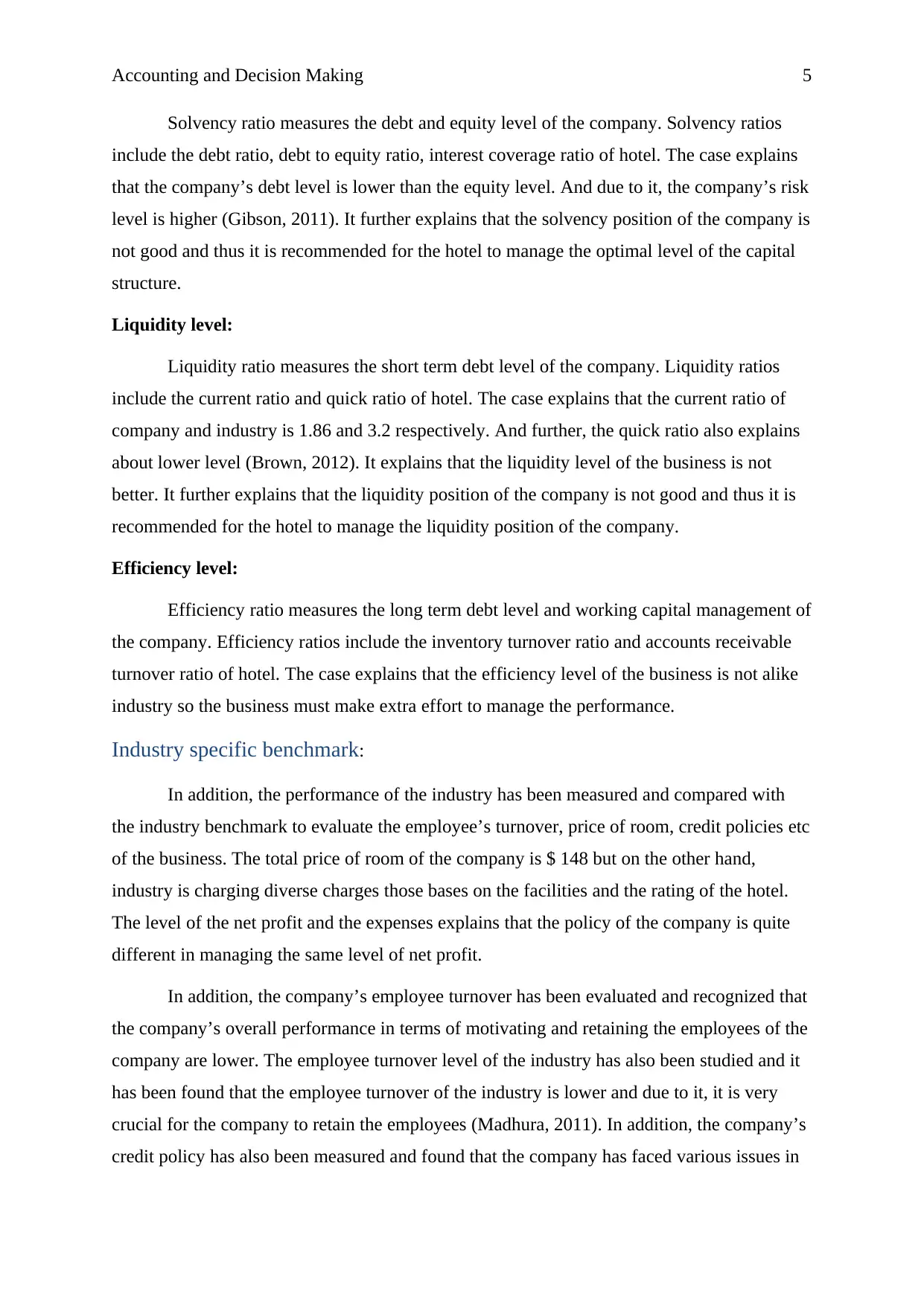
Accounting and Decision Making 5
Solvency ratio measures the debt and equity level of the company. Solvency ratios
include the debt ratio, debt to equity ratio, interest coverage ratio of hotel. The case explains
that the company’s debt level is lower than the equity level. And due to it, the company’s risk
level is higher (Gibson, 2011). It further explains that the solvency position of the company is
not good and thus it is recommended for the hotel to manage the optimal level of the capital
structure.
Liquidity level:
Liquidity ratio measures the short term debt level of the company. Liquidity ratios
include the current ratio and quick ratio of hotel. The case explains that the current ratio of
company and industry is 1.86 and 3.2 respectively. And further, the quick ratio also explains
about lower level (Brown, 2012). It explains that the liquidity level of the business is not
better. It further explains that the liquidity position of the company is not good and thus it is
recommended for the hotel to manage the liquidity position of the company.
Efficiency level:
Efficiency ratio measures the long term debt level and working capital management of
the company. Efficiency ratios include the inventory turnover ratio and accounts receivable
turnover ratio of hotel. The case explains that the efficiency level of the business is not alike
industry so the business must make extra effort to manage the performance.
Industry specific benchmark:
In addition, the performance of the industry has been measured and compared with
the industry benchmark to evaluate the employee’s turnover, price of room, credit policies etc
of the business. The total price of room of the company is $ 148 but on the other hand,
industry is charging diverse charges those bases on the facilities and the rating of the hotel.
The level of the net profit and the expenses explains that the policy of the company is quite
different in managing the same level of net profit.
In addition, the company’s employee turnover has been evaluated and recognized that
the company’s overall performance in terms of motivating and retaining the employees of the
company are lower. The employee turnover level of the industry has also been studied and it
has been found that the employee turnover of the industry is lower and due to it, it is very
crucial for the company to retain the employees (Madhura, 2011). In addition, the company’s
credit policy has also been measured and found that the company has faced various issues in
Solvency ratio measures the debt and equity level of the company. Solvency ratios
include the debt ratio, debt to equity ratio, interest coverage ratio of hotel. The case explains
that the company’s debt level is lower than the equity level. And due to it, the company’s risk
level is higher (Gibson, 2011). It further explains that the solvency position of the company is
not good and thus it is recommended for the hotel to manage the optimal level of the capital
structure.
Liquidity level:
Liquidity ratio measures the short term debt level of the company. Liquidity ratios
include the current ratio and quick ratio of hotel. The case explains that the current ratio of
company and industry is 1.86 and 3.2 respectively. And further, the quick ratio also explains
about lower level (Brown, 2012). It explains that the liquidity level of the business is not
better. It further explains that the liquidity position of the company is not good and thus it is
recommended for the hotel to manage the liquidity position of the company.
Efficiency level:
Efficiency ratio measures the long term debt level and working capital management of
the company. Efficiency ratios include the inventory turnover ratio and accounts receivable
turnover ratio of hotel. The case explains that the efficiency level of the business is not alike
industry so the business must make extra effort to manage the performance.
Industry specific benchmark:
In addition, the performance of the industry has been measured and compared with
the industry benchmark to evaluate the employee’s turnover, price of room, credit policies etc
of the business. The total price of room of the company is $ 148 but on the other hand,
industry is charging diverse charges those bases on the facilities and the rating of the hotel.
The level of the net profit and the expenses explains that the policy of the company is quite
different in managing the same level of net profit.
In addition, the company’s employee turnover has been evaluated and recognized that
the company’s overall performance in terms of motivating and retaining the employees of the
company are lower. The employee turnover level of the industry has also been studied and it
has been found that the employee turnover of the industry is lower and due to it, it is very
crucial for the company to retain the employees (Madhura, 2011). In addition, the company’s
credit policy has also been measured and found that the company has faced various issues in
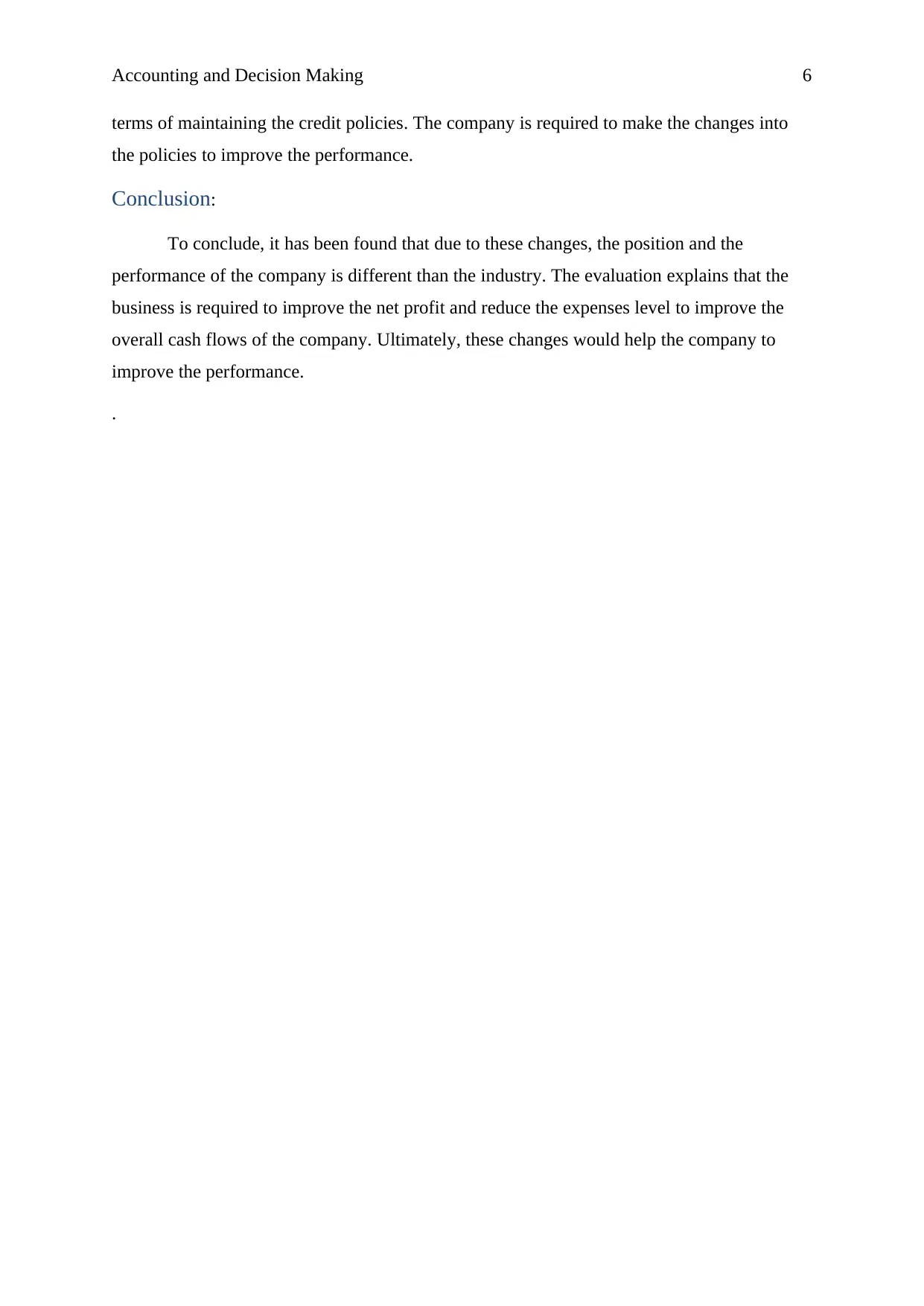
Accounting and Decision Making 6
terms of maintaining the credit policies. The company is required to make the changes into
the policies to improve the performance.
Conclusion:
To conclude, it has been found that due to these changes, the position and the
performance of the company is different than the industry. The evaluation explains that the
business is required to improve the net profit and reduce the expenses level to improve the
overall cash flows of the company. Ultimately, these changes would help the company to
improve the performance.
.
terms of maintaining the credit policies. The company is required to make the changes into
the policies to improve the performance.
Conclusion:
To conclude, it has been found that due to these changes, the position and the
performance of the company is different than the industry. The evaluation explains that the
business is required to improve the net profit and reduce the expenses level to improve the
overall cash flows of the company. Ultimately, these changes would help the company to
improve the performance.
.
⊘ This is a preview!⊘
Do you want full access?
Subscribe today to unlock all pages.

Trusted by 1+ million students worldwide
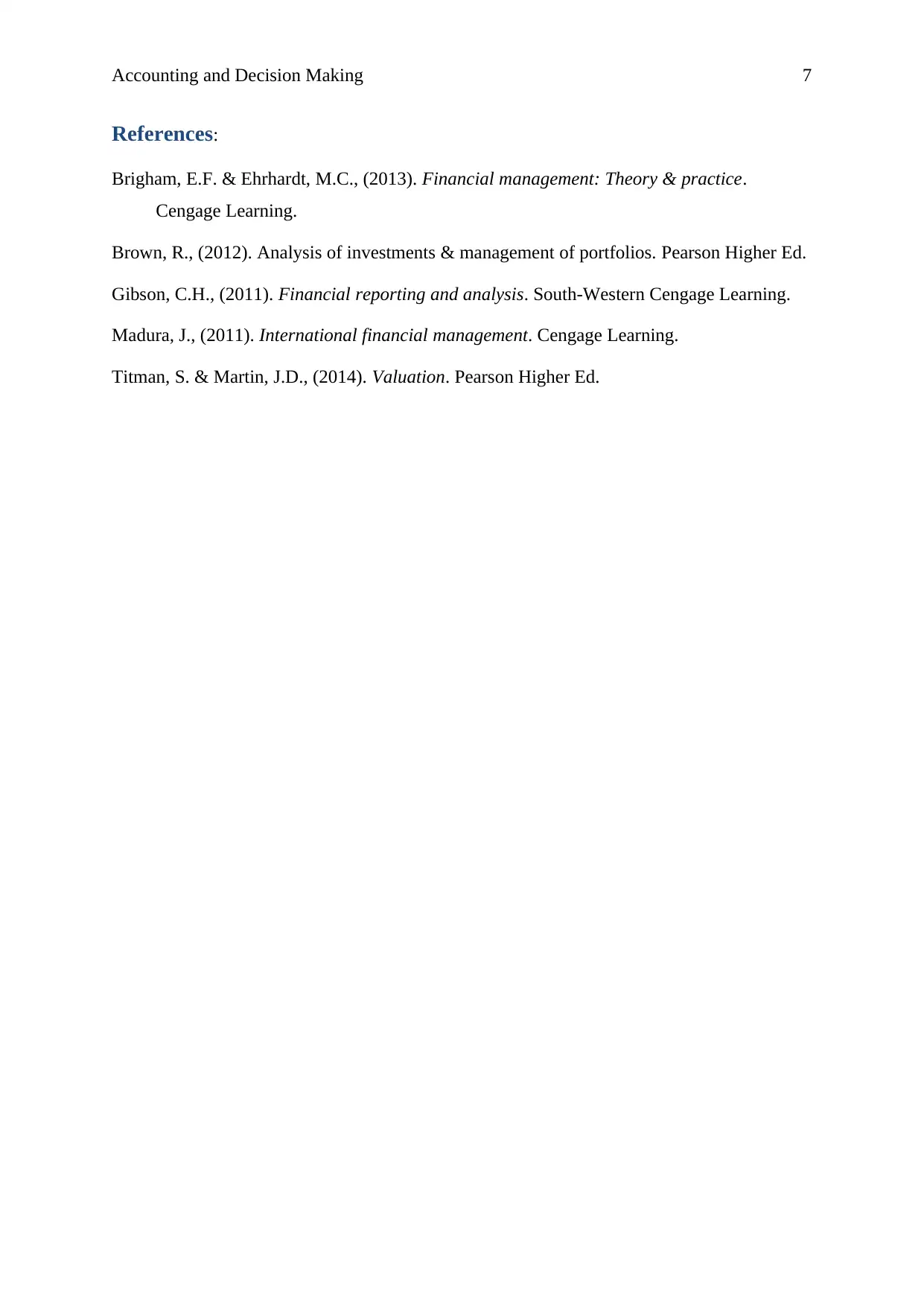
Accounting and Decision Making 7
References:
Brigham, E.F. & Ehrhardt, M.C., (2013). Financial management: Theory & practice.
Cengage Learning.
Brown, R., (2012). Analysis of investments & management of portfolios. Pearson Higher Ed.
Gibson, C.H., (2011). Financial reporting and analysis. South-Western Cengage Learning.
Madura, J., (2011). International financial management. Cengage Learning.
Titman, S. & Martin, J.D., (2014). Valuation. Pearson Higher Ed.
References:
Brigham, E.F. & Ehrhardt, M.C., (2013). Financial management: Theory & practice.
Cengage Learning.
Brown, R., (2012). Analysis of investments & management of portfolios. Pearson Higher Ed.
Gibson, C.H., (2011). Financial reporting and analysis. South-Western Cengage Learning.
Madura, J., (2011). International financial management. Cengage Learning.
Titman, S. & Martin, J.D., (2014). Valuation. Pearson Higher Ed.
Paraphrase This Document
Need a fresh take? Get an instant paraphrase of this document with our AI Paraphraser
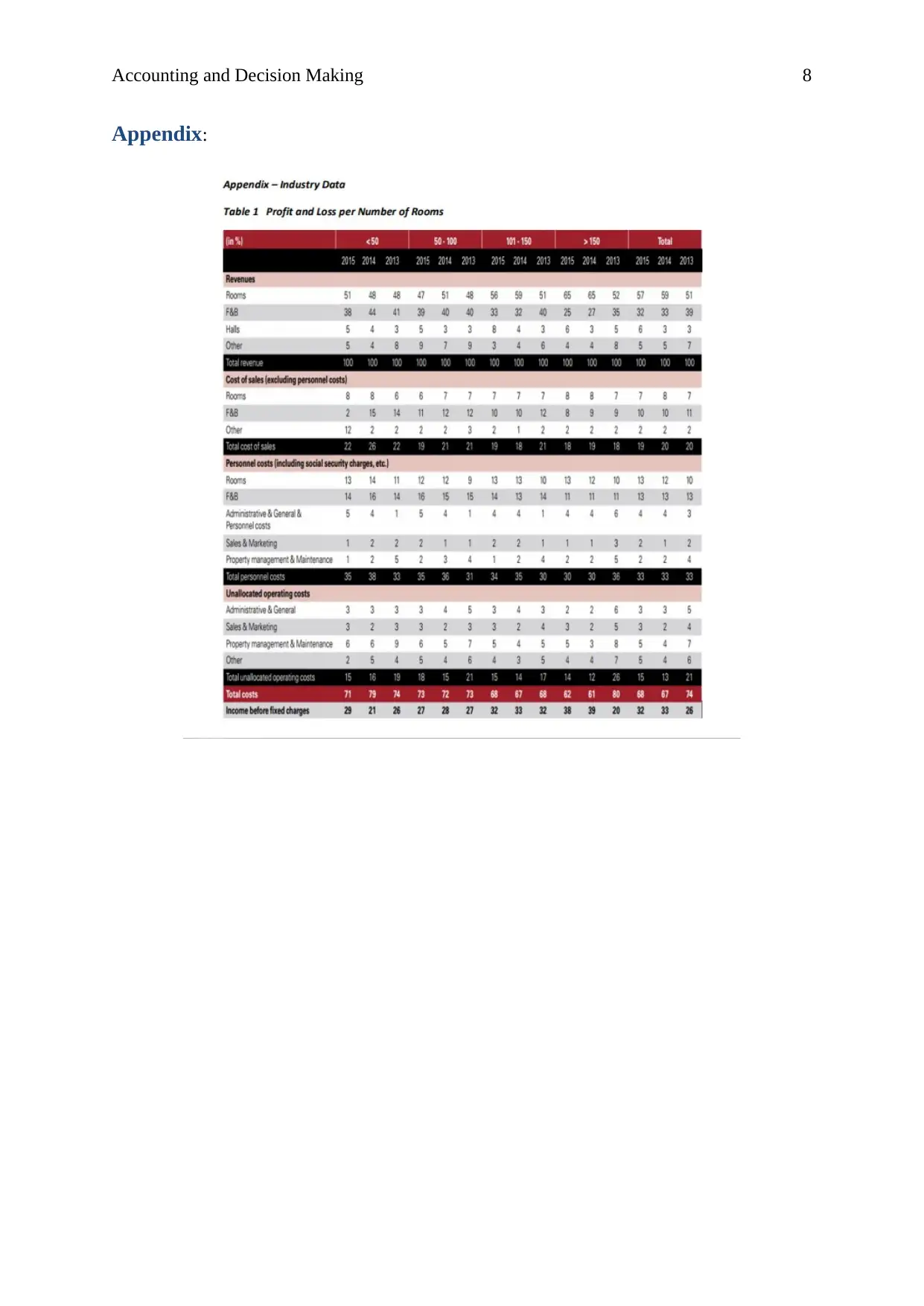
Accounting and Decision Making 8
Appendix:
Appendix:
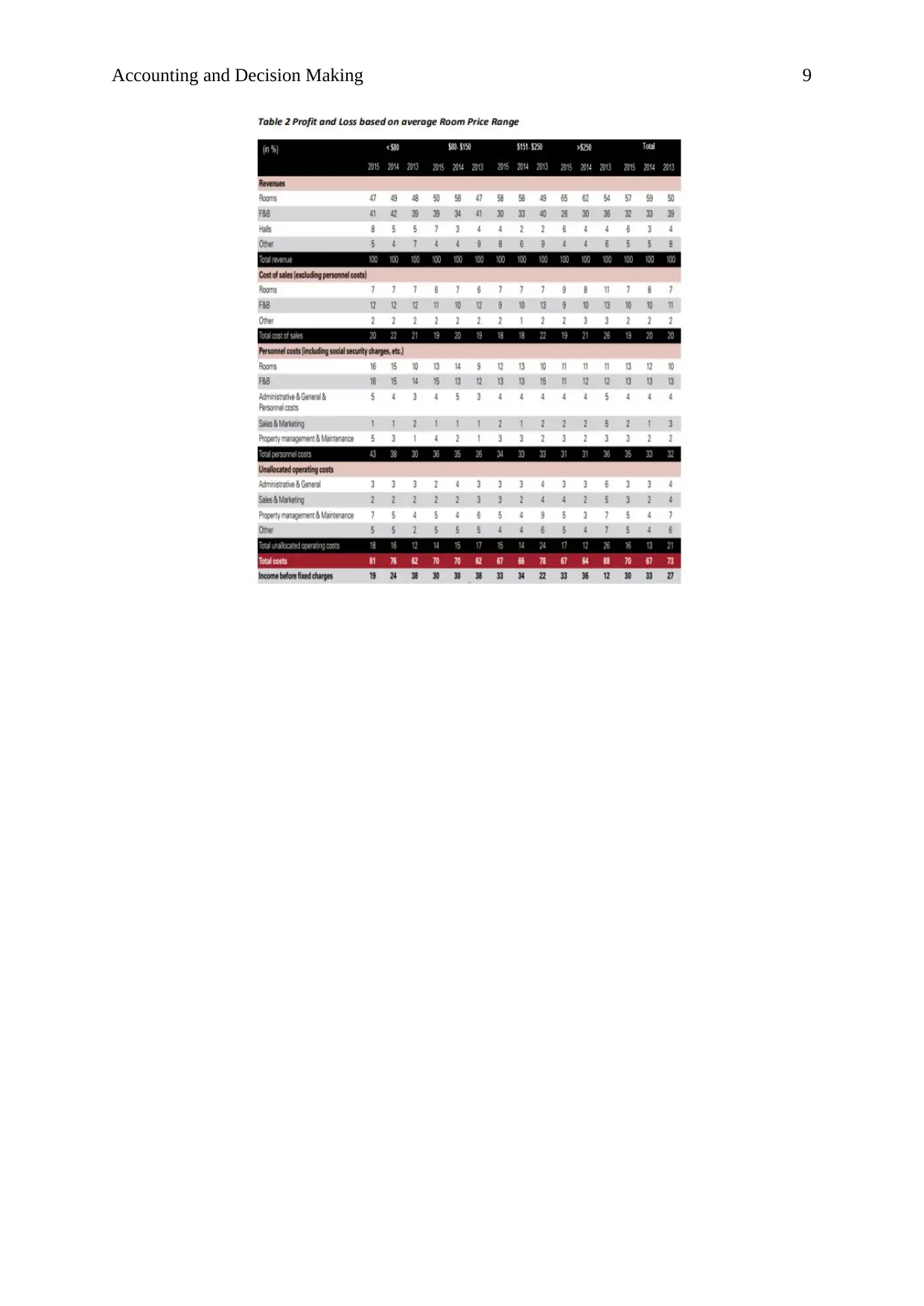
Accounting and Decision Making 9
⊘ This is a preview!⊘
Do you want full access?
Subscribe today to unlock all pages.

Trusted by 1+ million students worldwide
1 out of 9
Related Documents
Your All-in-One AI-Powered Toolkit for Academic Success.
+13062052269
info@desklib.com
Available 24*7 on WhatsApp / Email
![[object Object]](/_next/static/media/star-bottom.7253800d.svg)
Unlock your academic potential
Copyright © 2020–2025 A2Z Services. All Rights Reserved. Developed and managed by ZUCOL.



